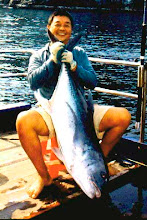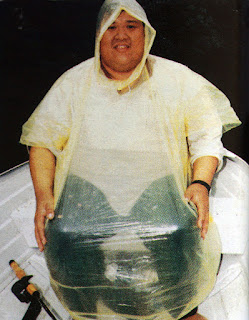 |
| This article was published in the April 2004 issue of Rod and Line Fishing Magazine. |
“Ng can you help me cull some haruans from my friend’s pond
ah?” asked Phang Yee Seng. “Huh!” I replied not trusting my ears. He repeated
the request, which made me laugh like a hyena. Phang’s request was just like
asking a tiger whether it can help take care of the lambs in a pan.
According to Phang, this pond belongs to his friend, Ah Foo.
Adult fish from other ponds were transferred here to be fattened up for the
market. Recently, he (Ah Foo) decided to stock this pond with thousands of
tilapia fries. What followed was the biggest “kenduri” held this side of the
Kinta Valley. Hordes of hungry haruans were circling schools of fries and
picking them off like the RAF fighters downing German bombers during the famous
Battle of Britain.
 |
| Meng with one of his haruans, taken with a spinner-bait. He was very successful with it. |
You see, the pond being too big and deep to be harvested by
the usual netting, had been left untouched for seven years. The method used to
harvest the fish here was by dumping food into a satellite pond. When the fish
rushed in to feed, a net was lowered to close the connecting channel and the
trapped fish could then be harvested at will. Imagine what piscatorial monsters
would lurk in a pond not harvested for seven years! Add to that, a gigantic
haruan was caught recently.
 |
| Here Phang was posing with one of his shell-spoon taken haruans. |
Standing on the edge of the pond and watching the mist
slowly cleared from the water surface, my hands were shaking as though going on
my first date. My heart was drumming like crazy, pounding something like IGFA,
IGFA, IGFA (IGFA record lah).
Ah Meng, using a weighted spinner bait and was the first to
lock onto a kilo plus haruan. After a few short runs (as all haruans do), it
was netted. This was followed by another, and another, then another. He seemed
to be the pipe piper for haruans. Phang was really frustrated after Ah Meng
caught his fifth haruan and started calling him Elvis (Chinese referred to
Elvis Presley as Mow Wong or King of Cats) in the process. Just when Phang was
at the point of exploding, a haruan hammered his frog bait and his scowl turned
into a smile.
 |
| It had been a long time since I got a haruan of this size. |
After taking some photographs for them (I had not started
fishing yet), I went off to a deeper part of the pond to fish. This part of the
pond had its banks covered by some overhanging shrubs. My theory was that, if
kid haruans of a kilo plus were hanging around the shallower parts then the great-grandpas
and great-grandmas must be somewhere else……where else?
Being relatively snag free, here I chose to use the shell spoon,
introduces by Robert Goh of Taiping. Surprisingly, there were no giant strikes,
as anticipated. A true follower of the concept of “The magic of thinking big”,
I kept on casting and retrieving the spoon. Maybe the haruans and I went to
different schools, for I just could not get any fish. From the corner of my eyes,
I could see that Phang and Ah Meng were catching and landing scores of them. In
the end, their “Got ANY (with emphasis on ANY) fish ah? “really got on my
nerves.
 |
| Surprise of all surprises, a marble goby took Phang's frog. |
Somehow, the IGFA record mission was abandoned and I rushed
over to where they were (All motivational training about being positive and persistent
went down the drain, or rather the pond). When my spoon hit the water, I
allowed it to sink a few seconds, before starting to retrieve. Giving my rod
tip a couple of twitches, I felt a light tug and wham, a kilo plus haruan was
my reward!
The haruans here were so plentiful that many a time, my
shell spoon was grabbed the moment it hit the water. Human beings are such,
when the pickings are good, they become choosy. Yours truly was guilty of it
too. You would not believe me if I were to say, we chose to cast to the big rises.
Remember, that the size of the swirl was directly proportional to the size of
the fish. This was the ultimate snobbish haruan fishing of the highest order, I
presumed.
 |
| This tilapia, held up by Ah Meng, was one of the few that hit my spoon. |
Haruans were not the only fish that were plentiful here. We
were surprised when Phang pulled up a marble goby (ketutu) when it grabbed his
frog bait. More surprise followed when a marble goby gobbled up my shell spoon.
Mind you, the shell spoon attracted the tilapias too, as proven by the few
specimens that I landed.
We were enjoying ourselves so much with the very cooperative
and presentable haruans that we forgot the time. My mission of catching the
IGFA record haruan was temporary forgotten too. Somehow the aim of catching record
size haruans was discarded quite fast when everyone was getting fish and you got
none. But your stomach always has the last say at the end of the day. When it
started rumbling and my hands started shaking from hunger, I had no choice but
to rest and have something to eat.
Plonking myself onto a piece of plank (of course making sure
there is no protruding nail) I made myself comfortable under a shed before
tucking into my ‘lunch’. Phang joined me later. While eating, he suddenly
announced, “Ng, do you think you are having a good life so far?” I was taken aback
by his question. Pondering for a while I answered apprehensive, “I think I am
ok.” “Go take a look at what the fish are eating and then answer my question
again,” he laughed.
Sauntering over to where Leo, the Indonesian worker, was preparing
food for the fish, I got the surprised of my life. He was cutting open packets
of large prawns, meatballs and Chinese silver pomfrets (Pamus chinesis) into a
big cauldron. Yes, Chinese silver pomfrets or ‘tow tai yee’ in Cantonese! I
headed back to where Phang was with head bowed and ego deflated. On the way
home all of us were in deep thoughts, maybe reflecting on our lives.
 |
| Leo, the Indonesian worker, putting pomfrets, meatballs and large prawns into the cauldron. |
The pond was so infested with haruans that it took us ten
more trips there before we encountered a pak koh (empty handed) day. Most of
the days we landed more than twenty haruans of over a kilo in size. Of course
we took only one or two for our kenduries, with the rest being returned to a beaming
Ah Foo.





















